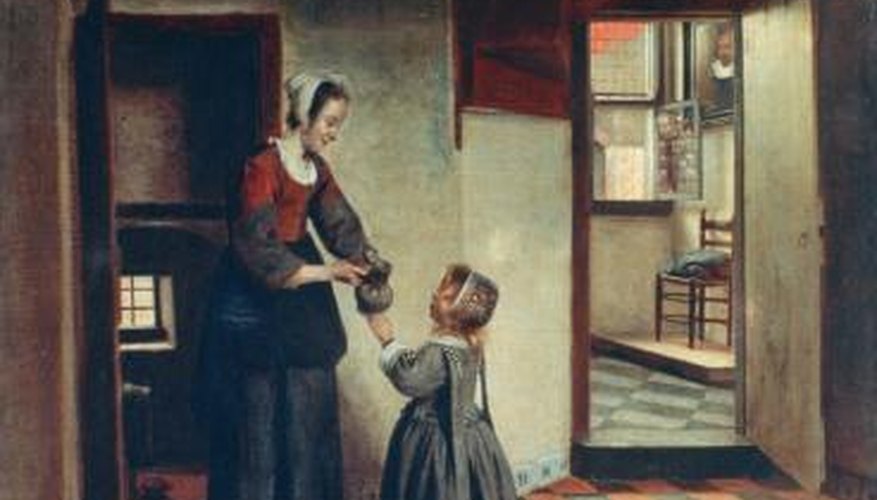Most children living in the 17th century had little time for toys. Life was tough and childhood was fleeting amid the many responsibilities and harsh realities of the times. Still, as children do, they managed to eke out idle moments of pleasure and fun. In each other's company, children commonly played games: race and tag games, singing games and hopping games -- the types of games easily started and abandoned when life and adults demanded. Toys were treasured. If not the lucky recipient of toy gifts, many children created their toys and a bit of time to enjoy them.
Tossing Toys
Children in the 17th century frequently fashioned toys from what they found either in nature or discarded by adults. Variations of marbles and jacks were played using bits of found bones, pebbles and stones. Youngsters poked strong sticks into rotten apples or potatoes and flung them as far as possible. A game of flinging rotting vegetation, notably apples, was called, "apple ball." An indoor variety of toss and catch was the cup and ball toy. A small ball was tossed into the air and caught in a cup attached to the end of a stick.
- Children in the 17th century frequently fashioned toys from what they found either in nature or discarded by adults.
- A small ball was tossed into the air and caught in a cup attached to the end of a stick.
Spinning Toys
Other toys often played indoors were whirligigs and spinning tops. Already widely popular for centuries, whirligigs were easily constructed by sliding a disk of hammered metal, wood or clay on a twisting loop of string and pulling both ends. If the creator of the toy chose to include scalloped edges on the disk, the toy buzzed as it whirled around the string. By the 17th century, several types of spinning tops were already available, including whip tops, peg tops and hand-spun tops. Scalloped edges on a top also created a buzzing sound, delighting children and adults alike.
- Other toys often played indoors were whirligigs and spinning tops.
- If the creator of the toy chose to include scalloped edges on the disk, the toy buzzed as it whirled around the string.
Rock, Roll and Slide
Rocking horses made their debut in early 17th century and quickly galloped into family life. The simplistic design of plank board sides used for the horse's legs ensured sturdy support for young riders. Rolling hoops with sticks also proved to be well-liked. Hoop and stick games abounded, but trundling a hoop across ground was also a solitary amusement. When adults could be pressed into nailing a few spare boards together, children used the boards for sledding down grassy slopes.
- Rocking horses made their debut in early 17th century and quickly galloped into family life.
- The simplistic design of plank board sides used for the horse's legs ensured sturdy support for young riders.
Play Imitates Life
Whether roughly carved or exquisitely detailed, replicas of people, animals and the world they inhabit have been a child's joy from the earliest times. Miniature living toys in 17th century included dollhouses, furnishings and human figures. The more elaborate miniatures were showpieces belonging to wealthy adults and were not intended for play. Girls' dolls were common and frequently made at home with scraps of fabric. Though they frowned upon too much time spent idly playing with the toy, mothers encouraged doll dressmaking as a life skill to be learnt.
- Whether roughly carved or exquisitely detailed, replicas of people, animals and the world they inhabit have been a child's joy from the earliest times.
- Girls' dolls were common and frequently made at home with scraps of fabric.
